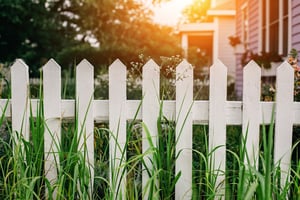 With the official start of summer near, you may be reviewing your “to do” list to start prioritizing your home projects. If putting up a fence is one of them, you’re not alone. With the variety of fencing materials available today, they’ve become a popular choice for many families.
With the official start of summer near, you may be reviewing your “to do” list to start prioritizing your home projects. If putting up a fence is one of them, you’re not alone. With the variety of fencing materials available today, they’ve become a popular choice for many families.
Whether you’re looking to build a fence to create a tranquil backyard or to keep your children or furry friend safe, there are some things you should keep in mind. Starting a project without proper planning can cause frustration, as well as extra time and money. If done right, fences can make your home more appealing and provide a return on your investment should you decide to sell it.
1. Talk to your city inspection department.
Depending on where you live, a permit may be required to install a fence. By talking with them, you’ll be able to identify zoning ordinances or laws that affect your construction project.
2. Identify its purpose.
Before starting your project, it’s important to understand why you want or need a fence. A fence provides many benefits, such as safety, security, privacy, and curb appeal. Choosing the right fence for your needs will determine the best materials for the job.
3. Select the proper materials.
There are many fencing materials available to select from. Options include:
- Wood
- Metal
- Vinyl
- Composite
4. Create a budget.
Now that you’ve identified its purpose and understand what materials are available, it’s time to start crunching numbers. A simple spreadsheet will allow you to plug in the numbers to determine the best option for you.
5. Review neighborhood guidelines.
If you belong to a homeowners’ association or live in a neighborhood with covenants, it’s best to know what’s acceptable before you start your project. Your neighborhood may have specific requirements that must be met, such as:
- Size of the fence
- Materials used for construction
- Views and visibility
- Style
Failure to follow the rules of your homeowners’ association could result in fines, penalties, and unwanted stress.
6. Review your property deed.
A property deed is a legal document that’s used to transfer property ownership. By reviewing your deed, you’ll be able to determine where your property line is. The last thing you’d want to do is to build a fence on your neighbor’s property. If you can’t find your deed, visit your local courthouse for assistance.
7. Contact your insurance agent.
Give your agent a call to see how your insurance policy will provide coverage for your new fence if it’s damaged or destroyed. Depending on if your fence is considered a separate structure or part of a building determines if the claim payment will be made on an actual cash value (ACV) or replacement cost value (RCV) basis. To learn more about this topic click here.
8. Call Diggers Hotline.
Buried underneath the dirt and grass in your yard are utility lines. These utility lines are for services to your home which include electric, gas, water, sewer, cable TV, and telephone. Digging up or damaging one of these lines could put you in harm’s way or create unnecessary and expensive repairs.
9. Hire a professional.
If you start your project and it’s harder than you thought, consider hiring a professional to finish it. Spending time and money only to have the fence start leaning or collapse can be upsetting.
Do you have any suggestions or information you’d like to share? I’d love to hear from you. Please share them in the box below.
This article is intended for general educational and illustrative purposes only and should not be construed to communicate legal or professional advice. Further, this article is not an offer to sell insurance. Please consult with your licensed insurance agent for specific coverage details and your insurance eligibility. All policies are subject to the terms, conditions, limitations, and exclusions contained therein.





